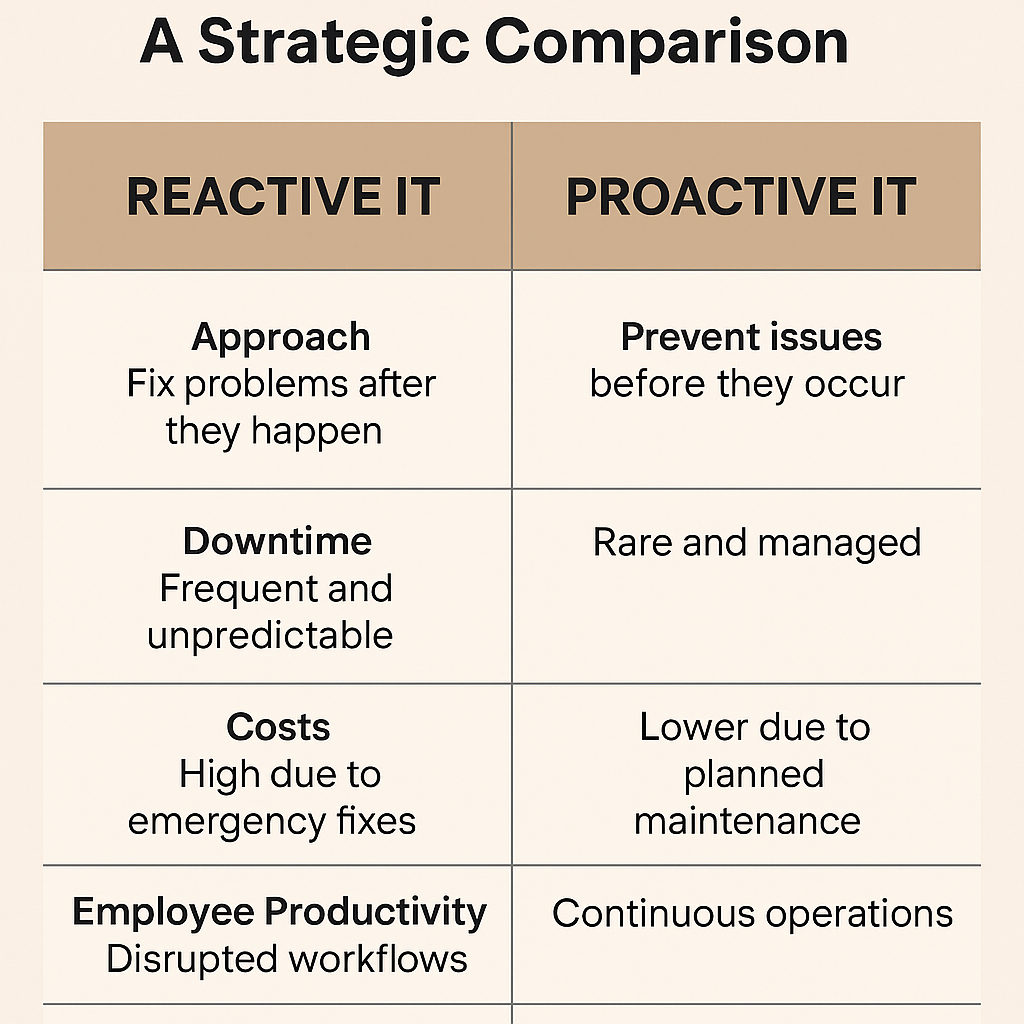Reactive vs. Proactive IT: A Strategic Comparison

Why Modern Leaders Need a Proactive IT Mindset
A proactive IT mindset allows leaders to see technology as a strategic asset rather than an operational burden. By preventing problems before they arise, leaders can reduce downtime, boost morale, and enhance company performance.
Anticipating Challenges Before They Disrupt Operations
Leaders who invest in predictive monitoring tools can detect server overloads, security breaches, and performance dips in real time. These early warnings make intervention swift and seamless.
Enhancing Business Continuity and Employee Productivity
When systems are consistently reliable, employees stay focused and motivated. Reduced IT disruptions mean more time spent on innovation, collaboration, and value-driven tasks.
The Leadership Advantage of Proactive IT Management
Leaders who embrace proactive IT stand out for their strategic foresight, cost efficiency, and ability to innovate.
Strengthening Organizational Resilience
Proactive IT builds business resilience, ensuring that even in the face of unexpected cyber threats or outages, recovery is quick and structured.
Driving Innovation Through Predictive Technology
Proactive systems free up resources, enabling teams to explore new technologies and process improvements—fueling innovation and competitive growth.
Cost Efficiency and Risk Reduction
According to Gartner, companies adopting proactive IT reduce unplanned downtime costs by up to 40% annually. These savings can be reinvested in scaling operations.
Core Components of a Proactive IT Strategy
A solid proactive IT framework includes several interconnected pillars:
- Real-Time Monitoring: Using AI-driven dashboards to monitor system health.
- Predictive Maintenance: Scheduling updates before components fail.
- Employee Cyber Awareness: Training staff to recognize potential threats.
- Strategic Vendor Partnerships: Collaborating with Managed IT Services for consistent support and expertise.
Leadership Practices That Promote Proactive IT Thinking
Effective leaders drive change through vision and culture.
- Set a Clear Vision for IT Modernization – Communicate why prevention matters.
- Empower Teams – Give IT professionals the authority and tools to act early.
- Reward Proactivity – Recognize employees who identify and mitigate risks.
Case Study: A Company That Benefited from Proactive IT
A mid-sized healthcare provider reduced IT downtime by 60% in one year after adopting proactive monitoring and routine system updates. Leadership’s shift from reactive firefighting to proactive oversight saved nearly $250,000 in productivity costs.
Implementing Proactive IT in Your Organization
- Assess Current IT Infrastructure
- Identify performance gaps and recurring issues.
- Establish Preventive Framework
- Develop KPIs for system uptime and security checks.
- Partner with Experts
- Collaborate with Managed IT Service Providers (MSPs) for proactive monitoring and 24/7 support.
(For a deeper dive, check out Microsoft’s guide on proactive IT management).
- Collaborate with Managed IT Service Providers (MSPs) for proactive monitoring and 24/7 support.
Measuring Success in Proactive IT
Track these key metrics:
- System uptime percentage
- Mean Time Between Failures (MTBF)
- Incident prevention rate
- User satisfaction scores
Future Trends: The Rise of Predictive IT Leadership
With AI-driven analytics and automation, future leaders will predict IT failures with remarkable accuracy. The next generation of IT leadership will rely on machine learning models that can prevent problems before they’re even detected by humans.
FAQs About Proactive IT Leadership
1. What is proactive IT management?
It’s a strategic approach that focuses on preventing IT issues before they occur through monitoring, maintenance, and analytics.
2. How does proactive IT save money?
By reducing emergency repairs and downtime, proactive IT significantly lowers unplanned expenses.
3. Can small businesses adopt proactive IT?
Yes—scalable solutions like managed IT services make proactive management affordable for SMBs.
4. How does proactive IT enhance security?
It identifies vulnerabilities early and applies timely patches, preventing breaches.
5. What tools support proactive IT?
Real-time monitoring software, endpoint protection, and predictive analytics platforms.
6. How can leaders encourage a proactive IT culture?
By fostering accountability, offering training, and rewarding preventive action.
Conclusion: Leading the Future Through Proactive IT
Leadership in the digital era requires more than crisis management, it demands foresight. By solving IT problems before they start, organizations protect their assets, empower teams, and position themselves for innovation and growth. Proactive IT isn’t just a strategy—it’s a leadership advantage that defines the future of success.
we can help
Did you enjoy this content?
Subscribe to our newsletter and get weekly tips on leveraging technology to supercharge your business operations. Don't miss out on the strategies that could transform your company!


.png)